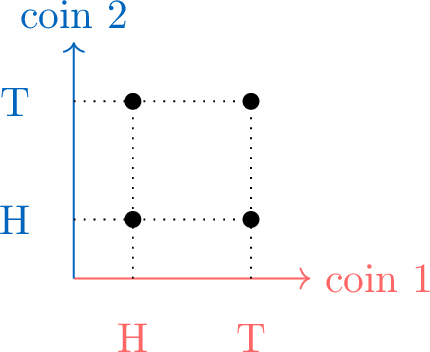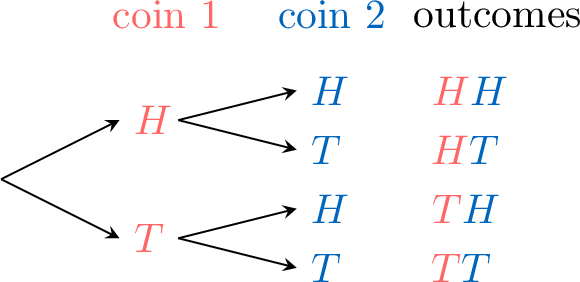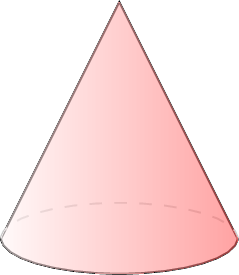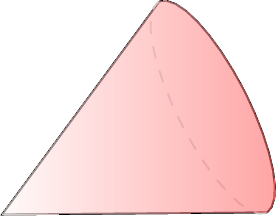Probability
Ever wondered if it'll rain tomorrow or if you'll win a game? That's probability! It's a math way to guess how likely things are to happen. Like when the weather app says there's a 90\(\pourcent\) chance of rain, that's probability telling us it's very likely. What else do you think we could use probability for?
Sample Space
Have you ever flipped a coin and wondered if it’d land on heads or tails? Or rolled a die and guessed what number you’d get? These are random experiments—things we do where the result isn’t certain until it happens.
Definition Outcome
An outcome is one possible result of a random experiment.
Definition Sample Space
The sample space is the list of all possible outcomes of a random experiment.
Example
What’s the sample space when you flip a coin?
It’s \(\{\)Heads, Tails\(\}=\{\) ,
, \(\}\), or just \(\{\)H, T\(\}\) for short.
\(\}\), or just \(\{\)H, T\(\}\) for short.
Example
What’s the sample space when you roll a six-sided die?
It’s \(\{\)1, 2, 3, 4, 5, 6\(\}=\{\) ,
, ,
, ,
, ,
, ,
,  \(\}\).
\(\}\).
Events
Definition Event
An event is a set of outcomes from all possible outcomes.
In math, we use capital letters like \(E\) to name events. So, we might say \(E\) is the event “it’s sunny tomorrow.”
Example
You roll a die. Let \(E\) be the event of rolling an even number. What’s \(E\)?
The sample space is \(\{1, 2, 3, 4, 5, 6\}\), and \(E = \{2, 4, 6\}\) because those are the even numbers.
Complementary Event
Definition Complementary Event
The complementary event of an event \(E\) is everything in the sample space that isn’t in \(E\). We call it \(E'\) (\(E\)-prime).
Example
You roll a die, and \(E\) is rolling an even number. What’s \(E'\)?
\(E = \{2, 4, 6\}\), so \(E'\) is all the other numbers: \(E' = \{1, 3, 5\}\). These are the odd numbers!
Multi-Step Random Experiments
A multi-step random experiment is one that involves a sequence of actions, where each action (or step) has its own set of possible outcomes. In our example of tossing two coins, the experiment is multi-step because it involves two separate coin tosses:
- The first coin toss (step 1) can result in Heads (H) or Tails (T).
- The second coin toss (step 2) can also result in Heads (H) or Tails (T).
Method Representations of Multi-Step Random Experiment
When an experiment involves more than one step, we can represent the sample space (the set of all possible outcomes) in several ways:
- using a grid (to visually map combinations along two axes),
- using a table (to organize outcomes in rows and columns),
- using a tree diagram (to follow each sequential step), or
- by listing all possible outcomes.
Example
For the random experiment of tossing two coins, display the sample space by:
- using a grid
- using a table
- using a tree diagram
- listing all possible outcomes
-

-
\(\begin{aligned} & \textcolor{colorprop}{\text{coin 2}} \\ \textcolor{colordef}{\text{coin 1}} \end{aligned} \) \(\textcolor{colorprop}{H}\) \(\textcolor{colorprop}{T}\) \(\textcolor{colordef}{H}\) \(\textcolor{colordef}{H}\textcolor{colorprop}{H}\) \(\textcolor{colordef}{H}\textcolor{colorprop}{T}\) \(\textcolor{colordef}{T}\) \(\textcolor{colordef}{T}\textcolor{colorprop}{H}\) \(\textcolor{colordef}{T}\textcolor{colorprop}{T}\) -

- \(\{\textcolor{colordef}{H}\textcolor{colorprop}{H}, \textcolor{colordef}{H}\textcolor{colorprop}{T},\textcolor{colordef}{T}\textcolor{colorprop}{H}, \textcolor{colordef}{T}\textcolor{colorprop}{T}\}\)
Probability
Definition Probability
The probability of an event \(E\), written \(P(E)\), tells us how likely \(E\) is to happen. It’s always a number between 0 and 1:
- 0 means impossible (0\(\pourcent\) chance).
- 1 means certain (100\(\pourcent\) chance).
We can show probability as a fraction, decimal, or percentage. Like a 50-50 chance is \(\frac{1}{2}\), 0.5, or 50\(\pourcent\). Picture it on a number line: 0 is impossible, 1 is certain, and 0.5 is right in the middle!

Example
What’s the probability the sun rises tomorrow morning?
It’s 1 (or 100\(\pourcent\)) because it’s certain!
Calculate Probabilities
Sometimes, every outcome in an experiment has the same chance—like flipping a fair coin or rolling a fair die. We call these equally likely outcomes.
Definition Equally Likely
If all outcomes are equally likely, the probability of an event, \(E\), is given by $$P(E) = \frac{\text{number of outcomes in the event}}{\text{total number of all possible outcomes}}$$
Example
What’s the probability of rolling an even number with a fair six-sided die?
- Sample space = \(\{1, 2, 3, 4, 5, 6\}\) (6 outcomes).
- \(E = \{2, 4, 6\}\) (3 outcomes).
- $$\begin{aligned}P(E) &= \frac{3}{6}\\&= \frac{1}{2}\end{aligned}$$.
Complement Rule
Proposition Complement rule
For any event E and its complementary event E', $$P(E) + P(E') = 1 \quad \text{or} \quad P(E') = 1 - P(E).$$
Example
Farid has a 0.8 (80\(\pourcent\)) chance of finishing his homework on time tonight (event \(E\)). What’s the chance he doesn’t finish on time?
The complementary event \(E'\) represents the scenario where Farid does not complete his homework on time tonight. As \(P(E) = 0.8\), by the complement rule, we get:$$\begin{aligned}P(E') &= 1 - 0.8 \\&= 0.2\end{aligned}$$So, there’s a 20 \(\pourcent\) chance he doesn’t finish on time!
Experimental Probability
Isaac wants to know how a cone lands when he tosses it—base down or point down? Here’s what it can do:
- Base down:

- Point down:

- Base down: 30 times.
- Point down: 20 times.
- \( P(\text{"base down"}) = \frac{30}{50} = 0.6 \) (60\(\pourcent\)).
- \( P(\text{"point down"}) = \frac{20}{50} = 0.4 \) (40\(\pourcent\)).
Definition Experimental Probability
The probability \( P(E) \) of an event \( E \) can be estimated using the formula:$$P(E) \approx \frac{\text{number of times the event occurs}}{\text{number of trials}}$$